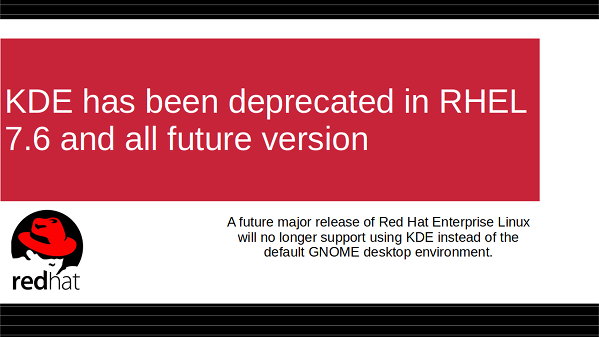Red Hat Enterprise Linux is well known to set defaults across the industry. For example, RHEL pushed systemd so hard that all other Linux distro adopted for good or bad reasons. Now Red Hat announced that KDE Plasma Workspaces (KDE) been deprecated from RHEL 7.6 and all future version of RHEL.
KDE has been deprecated

From the RHEL 7.6 release note:
KDE Plasma Workspaces (KDE), which has been provided as an alternative to the default GNOME desktop environment has been deprecated. A future major release of Red Hat Enterprise Linux will no longer support using KDE instead of the default GNOME desktop environment.
Don’t worry. KDE is not dead yet!
Red Hat is moving KDE to EPEL (Extra Packages for Enterprise Linux) repo. To install KDE on a CentOS or RHEL or Fedora, you need to setup EPE repo. Fedora act as a test bed and upstream distro for RHEL. However, Red Hat is not going to put engineering and Software quality assurance (SQA) resources in KDE. The official Red Hat policy for to EPEL repo is as follows:
- The following information has been provided by Red Hat, but is outside the scope of the posted Service Level Agreements and support procedures.
- Installing unsupported packages does not necessarily make a system unsupportable by Red Hat Global Support Services. However, Red Hat Global Support Services will be unable to support or debug problems with packages not shipped in standard RHEL channels.
- Installing packages from EPEL is done at the user’s own risk.
- The EPEL repository is a community supported repository hosted by the Fedora Community project.
- The EPEL repository is not a part of Red Hat Enterprise Linux and does not fall under Red Hat’s Production Support Scope of Coverage. The repository is considered an optional repository and is not tested by Red Hat quality engineers.
Above rules indicate that, KDE is unsupported by Red Hat. It makes me nervous as other Linux distro follows Red Hat policies.
Gnome for Linux business users
RHEL and CentOS mostly used by business users who wants stability over cutting-edge software. You get a long-term support contract with RHEL. Red Hat has made up its mind. They are going to support one desktop environment. As a sysadmin, I find this is useful as I no longer have to support other DEs. Red Hat is also one of main sponsors of GNOME 3 desktop. It makes sense like other products to support GNOME 3 out of the box especially RHEL 7.6 workstation:
Designed for advanced Linux users working on more powerful hardware, Red Hat Enterprise Linux Workstation is optimized for high-performance graphics, animation, and scientific activities. It includes all the capabilities and apps from Red Hat Enterprise Linux Desktop, plus development tools for provisioning and administration.
Options for KDE users/fans
The virtue of open source resides in the fact that its code is free and can always be edited, modified, and customized to your needs. Don’t like change? Get a Linux distro that supports KDE out of the box. KDE project will continue to develop software without any support from Red Hat. RHEL/CentOS 7.6+ users can either use EPEL repo or switch other Linux distros such as Ubuntu, Debian, SUSE/OpenSUSE and others.
Conclusion
The power of the defaults plays a significant role in the Linux ecosystem. Again take the example of systemd. Most users tend to stick to the defaults and defaults are incredibly powerful tools for setting up future of the Linux desktop. I don’t like this kind of manipulation. It is not healthy for anyone in the long run. What do you think? Add your thoughts in the comments section.
(via theregister)
